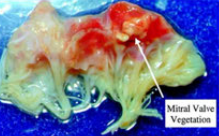NUHS Institutions will NEVER ask you to transfer money or disclose bank details over a call.
If in doubt, call the 24/7 ScamShield helpline at 1799, or visit the ScamShield website at www.scamshield.gov.sg.
World's Largest Infective Endocarditis Registry
Improving disease treatment outcomes with new research insights
PULSE Issue 40 | January 2023
Blood culture-negative endocarditis (BCNE) is endocarditis in which blood cultures using usual laboratory methods remain sterile, and account for 2.5% to 70% of all cases of endocarditis, depending on countries. This geographical variation in incidence is explained by several factors including differences in the diagnostic criteria used; specific epidemiological factors, as it is the case for fastidious zoonotic agents; variations in the early use of antibiotics before blood sampling; differences in sampling and testing strategies; and involvement of unknown pathogens or non-infective etiologies.

Identification of the causative microorganism is crucial to select an appropriate targeted antibiotics therapy that, together with surgical debridement whenever indicated, represents the mainstay of the therapeutic approach to infective endocarditis.
Seniors consultants from the Department of Cardiology, National University Heart Centre, Singapore (NUHCS) - Adj A/Prof William Kong Kok Fai, Clinical Director of Echocardiography and Non-Invasive Diagnostic Cardiology, Adj Prof Poh Kian Keong, Director of Research, and A/Prof Yeo Tiong Cheng, Group Chief of Cardiology, National University Health System (NUHS) - conducted a multi-centre study within the European Society of Cardiology (ESC), known as the EUR-Observational Research Programme (EORP) European Endocarditis (EURO-ENDO) international registry which records data from the world's largest cohort of patients admitted to hospitals in Europe and Non-Europe countries (3,113 patients from 156 centres across 40 countries).
The ancillary analysis showed that 16.8% of patients in ESC EORP EURO-ENDO were culture negative. Most noticeable, patient characteristics showed that patients with culture-negative endocarditis were younger on average and adult congenital heart disease was more prevalent. The 30-day mortality rate was found to be higher in the negative group than in the positive group of patients. Among the patients who are qualified for surgery, patients with negative culture were operated less frequently as compared to those with a positive culture.
No difference in one-year survival was observed between the culture-negative group and the culture-positive group in the subgroup of surgically treated patients. A lower survival for the culture-negative group was observed in the patients receiving medical treatment alone.
With the publication of this study, the research team hope physicians treating endocarditis would be encouraged to secure proper cultures at an early stage of the disease and aim to reduce the prevalence of culture-negative endocarditis. Identifying a proper causative organism early can potentially modify patients' risk and hopefully improve their outcomes.